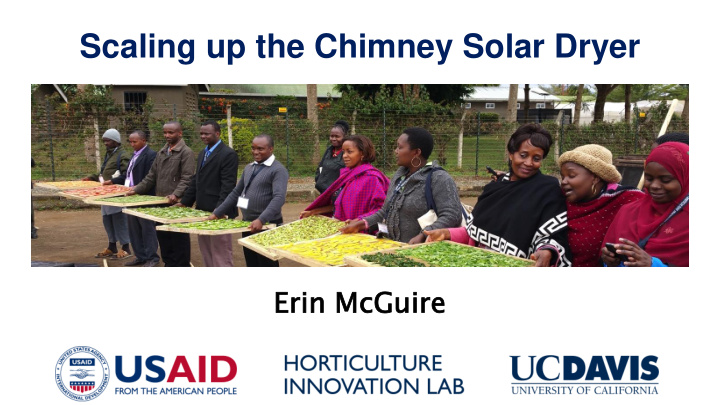



Scaling up the Chimney Solar Dryer Erin in McGuir ire
Horticulture Innovation Lab • Managed by UC Davis since 2009 • Awards grants to U.S. university researchers to conduct research in collaboration with developing country partners • Seed systems, production practices, postharvest handling and market access • Emphasis on innovative technologies, nutritious foods and women’s empowerment
Solar drying to preserve food – an opportunity for small-holder farmers • Low market prices during production peaks • Drying can preserve excess product • Provides an ‘added value’ product for year-round use or sale • Open air drying problematic • Existing ‘cabinet’ dryers are expensive and inefficient
Chimney Solar Dryer A cost-efficient structure that reduces drying time compared to other solar dryers Advantages: • Higher drying speeds • Works in unfavorable weather conditions • Portable • Protects from contamination • Does not require electricity or expensive tools
The chimney dryer concept • Use a chimney to draw the air through the tunnel • Use a clear plastic tunnel to collect solar energy – free heat. • Place the product at the top of the tunnel, where the warmer air is. • Fill unused parts of the tunnel to increase air speed past the product.
Chimney Dryer construction timelapse
Chim imne ney y Cabin inet et Dryer Sola So lar r Dry ryer r 200 Material costs (S) 58.84 10 Fruit capacity, fresh weight 5 (kg) 2 Time to dry fruit to 10% MC 5.5 (11h days) 7.27 Cost per drying capacity 11.77 ($/kg-drying period) 58.33 Highest air temp. in dryer – 46.67 ambient (°C) 0.63 Air velocity (m/s) 0.11
Scaling the chimney dryer • Prototypes at Innovation Centers • Construction at short courses • Informational materials • Videos • Fact sheets • Construction manual • Website
Dissemination/Extension - Regional Centers of Innovation and Service Centers • Goal is to be a regional resource center for trainings, technology, research, and scaling of technology in order to improve the resilience, nutrition, and income of small-holder farmers with a focus on gender equality • Improves sustainability of efforts • Zamorano University, Honduras • Latin America and Caribbean Center • Kasetsart University, Thailand • Southeast Asia Center • Guinea Service Center • Rwanda Post-Harvest Handling Centers • UC Davis 9
Chimney Solar Dryers in Bangladesh • Early data shows positive net value after one year, and profit margins continue increasing • Baghar: conservative projection based on lack of local market prices (products have no established commercial value) • Drying products with high unit price (pulses, fish, mango leather, chilies, groundnuts), helps to promote a positive net present value
Constraints to scaling • Principles have proven difficult to communicate • Materials can be difficult to obtain • Greenhouse-grade plastic • Using PVC clear cover instead of PE • Food-grade mesh for trays • Low quality of wood • Lack of market for dried foods
The small-scale entrepreneurial model for scaling • Pioneered with the DryCard ™ • Small-scale and/or new entrepreneurs identified in- country • We provide a ‘start - up’ package of needed materials • They provide tools (printer, laminator) and labor • We provide quality control, technical advice, brand recognition
Use our DryCard ™ entrepreneurs • Empower them to be agents for ‘tools for the dry chain’ • Dryers (Chimney dryer, pallet dryer) • DryCards • Drying beads • Packaging (PICS bags etc.) • Sell materials and know-how • Construct dryers on site and provide operational guidance and technical support
Potential benefits of this scaling strategy • Ensures local ownership and sustainability • Allows us to provide on- going technical assistance • Tests different local marketing strategies • Lottery (Uganda) • NGO facing (Rwanda) • Ag dealership (Ghana) • Social enterprise (Thailand)
Potential partnerships and future work • Identify areas where drying is a challenge • Identify cultures where dried products are traditionally consumed • Expand in more countries • Work with existing PICS bags network
Recommend
More recommend